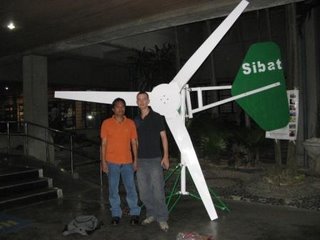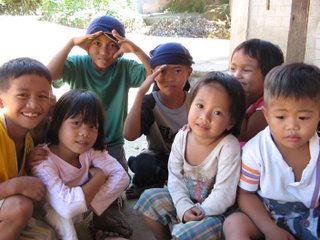Placement Summary
Apologies to anyone previously following my blog - it's been a while. I stopped during a hectic period of my placement when many aspects of the project were changing. When things settled and I had time again to write things were so different I found it difficult to continue. Anyway, here is a final project summary and some photos presented to EWB-UK and sponsors at the end of my placement.....
The wind turbine system installed at Buli.
The aim of my placement was to develop small wind turbines as a CBRES technology. Funding for the implementation of a CBRES employing a small wind turbine was obtained by SIBAT from the World Bank prior to my placement. By demonstrating that small wind energy is an appropriate CBRES technology in the Philippines SIBAT’s wind energy program should grow to support the development efforts of many more communities. Removing some of the barriers to implementation will allow for easier, cheaper and faster replication of the system. This will give SIBAT, and importantly, key funding agencies, confidence in the technology to implement future projects.
Wind turbines are a good alternative to expensive solar power and unsustainable diesel generation for communities without access to a suitable water source for micro hydro systems. The WWF has estimated that the Philippines has 7,600 MW of potential capacity for commercial wind energy, making it the windiest country in South East Asia and full of potential for small wind energy systems.
During my placement we installed a wind/solar powered potable water system in Buli, a remote island community approximately 160 km south west of Manila. The community has 140 households and a population of approximately 700. The community draw water from a 35 m deep well using containers and a rope pulley. The containers are then carried from the well at the centre of the community to the individuals’ household – some up to 1.3km from the well site. It is the daily job of the men and the boys, some as young as 10, to collect water. Usually 4 or 5 journeys a day per household would be made. Clearly this task is a major burden on the community in terms of hardship endured and time spent that could be used for livelihood activities. It also limits the water available for cooking, personal cleaning and washing - likely resulting in incidents of disease and infections.
The wind turbine at Buli.
A detailed feasibility study determined the area had a sufficient wind resource and that the community was suitable to sustain a wind energy system. Through community meetings and discussions it was decided a potable water pumping system would be the most appropriate application. The community volunteered the labour counterpart for the construction of the project, taking 10-12 men approximately 2 weeks in all.
The wind turbine and solar panels power an electrical submersible pump that delivers water to a temporary reservoir tank at the surface near the well. The community can then dispense water and carry it to their houses. The National Anti-Poverty Commission, a Philippine government agency has approved additional funding for a 75 m3 elevated steel tank and piping that will be able to distribute water to clusters of households in the community. Clearly, integrating this into the system will further reduce the burden of water collection and limited usage on the community. The installation will commence after the rainy season in November or December 2007. The community is very proud and excited to be the benefactors of the project and realising the benefits of the RE system. Hopefully their hard work in construction and continued discipline in operation and maintenance will ensure their system is sustained.
A 10 yr old boy collecting water in Buli.
A major step in the development of the technology is the establishment of local manufacturing capabilities for medium scale production of the 1kW small wind turbine. During my placement relations were established with a private machine shop and fiberglass fabricators so machines can be built with minimal engineering time input from SIBAT staff. Standardization of processes, materials, hardware and equipment will reduce the cost, time and risk of implementing future projects. Local manufacturing gives SIBAT the capacity to repair and develop the machine, avoids expensive import duties and provides benefits for the local economy.
Development of a robust feasibility tool for the technical assessment of a potential site has also been a key part of my placement. The energy output of a wind turbine is determined by the average wind speed at the site, so it is vital to have a robust tool for analysis of a proposed site’s wind resource and achieving a sustainable system design.
The wind turbine, first developed by Practical Action (a UK based charity), has been employed as a development tool by NGOs in other developing countries including, Nicaragua, Zimbabwe and Sri Lanka. Sharing of experiences and knowledge between the various organizations is to be encouraged.
I thoroughly enjoyed my placement in the Philippines and had many great experiences. The SIBAT staff were incredibly friendly and supportive. I had many journey to remote communities all over the Philippines and was always warmly welcomed by the people there. It was interesting to get to know the culture over the course of the year, helped by my intermediate understanding of Tagalog (the Philippines national language). I gained a vast amount of experience, improving my technical skills, knowledge of organizations, and working with various stakeholders such as community groups, businesses, local and national government and international funding agencies. I learnt a great deal about development theory and practice.
I graduated from Mechanical Engineering MEng course from The University of Nottingham in July 2006 and more than a few experiences that provided good preparation for the placement. I was involved in establishing an EWB-UK Nottingham branch with fellow students during my final year there. As part of this group I was the project manager for the manufacture of a prototype small wind turbine, very similar to the one used by SIBAT. A course in Wind Energy Converters whilst on exchange at UNSW in Australia gave a good introduction to wind energy engineering and the wind energy industry.
I intend to return to the Philippines as a volunteer for another 12 months to continue work developing the wind energy program. I have made an application with VSO to continue the work with SIBAT under their program. I feel the placement has given me an excellent base for a future career in development and renewable energy.



















